 by: Tami O’Connor
by: Tami O’Connor
Let’s face it, kids of every age love gooey substances! The school year is never complete until you and your students make slime. Depending upon your grade level, the topic you’re teaching, your classroom budget, and the time you have available, there are a number of options open to you.
One of my favorite “recipes” is the ever popular Elmer’s Glue Gak. Aside from the fact that it’s easy to make, it’s rare that you wouldn’t have most of the essential ingredients at your fingertips.
To make Gak:
You will need equal parts of Elmer’s glue-all and water. I tend to use two cups side by side and pour about 1/4 cup of glue in one and an equal amount of water in the other. Students can easily judge if the two liquids are equal without messing around with measuring cups. Pour the 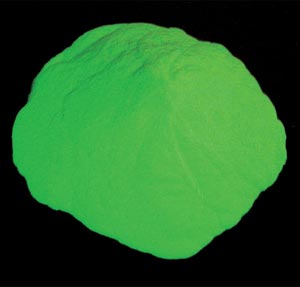 water into the glue and stir well.
water into the glue and stir well.
At this point, you can add food coloring, or better yet, phosphorescent Glow-in-the-Dark Pigment so your gak will glow in the dark. If you’re using food coloring, only 4 or 5 drops are necessary.
In a separate cup you will need to mix hot water and Borax (sodium tetraborate) until you have a saturated solution. 20 Mule Team Borax can usually be found in your grocery store in the laundry aisle. I explain to my students that the water is saturated when the powder no longer dissolves in it. Evidence that you have a saturated solution is when the powder remains on the bottom of the beaker or glass even after the liquid is stirred well.
While mixing the glue mixture, slowly add the Borax solution. Students will immediately find that the glue mixture begins to clump and turn from a liquid to more of a putty-like solid. This is because the sodium tetraborate is a cross linking agent that hydrogen-bonds with the long polymer molecules found in the Elmer’s glue.
Another favorite gooey activity is slime making…. For this, I always use polyvinyl alcohol. I love using the hot water soluble Polyvinyl Alcohol Bags 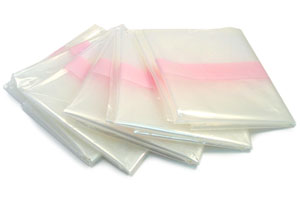 commonly used in hospital laundry rooms. Typically, these bags are used to place soiled linens within them reducing the chance that a hospital worker will come into contact with contaminants. When the bag, filled with sheets etc. is thrown in the washing machine, the hot water dissolves the bag exposing the linens to the water and detergent. When the water leaves the washing machine, so does the dissolved PVA.
commonly used in hospital laundry rooms. Typically, these bags are used to place soiled linens within them reducing the chance that a hospital worker will come into contact with contaminants. When the bag, filled with sheets etc. is thrown in the washing machine, the hot water dissolves the bag exposing the linens to the water and detergent. When the water leaves the washing machine, so does the dissolved PVA.
To make Slime:
To make slime, dissolve the PVA bags in hot water (the appropriate amount is in the directions), and then slowly stir in the same Borax solution used to make Gak. The basic difference between slime and Gak is textural and color. Gak is opaque while slime is more transparent, and slime tends to be a little thinner and less putty-like. As with Gak, slime can be colored by using a couple of drops of food coloring before adding the Borax solution. Or you can try our Pick-Your-Color Slime kits!
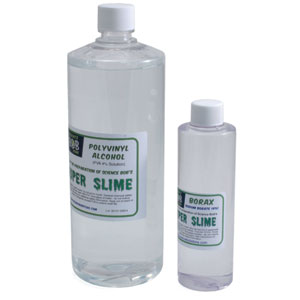 For those teachers who have less time to spare, Educational Innovations carries a variety of Classroom Slime Kits that have everything you need premixed. All you have to do is combine the PVA solution and Borax solution and voila… instant slime!
For those teachers who have less time to spare, Educational Innovations carries a variety of Classroom Slime Kits that have everything you need premixed. All you have to do is combine the PVA solution and Borax solution and voila… instant slime!
Finally, the gross fluid that behaves like a liquid and a solid; Oobleck! When allowed to sit in its container, Ooblek behaves like a liquid. As soon as pressure is applied, this non-newtonian fluid behaves like a solid. It can be rolled into a ball, but then as soon as you stop rolling, it “melts” in your hands! Kids love experimenting with this material!
To make Oobleck:
Oobleck is easily made by using two parts cornstarch to one part water. If you are planning to color your Oobleck, it’s easiest to color the water you add to the cornstarch. Finally, if you are working with younger children, the perfect literature connection is Dr. Suess’s Bartholomew and the Oobleck.
Clean-up for any of the gooey mixtures is fairly simple. A warm soapy sponge should clean most flat surfaces. It’s a good idea to keep any of the polymers away from clothing or carpeting, especially if you use food coloring. With the exception of the Borax solution, I would avoid putting anything else down the drain, but putting them in the garbage can should be fine… Be sure there is a plastic liner in the can or you will not be the custodian’s favorite teacher!
2018 UPDATE:
How about some Frog Floam?!
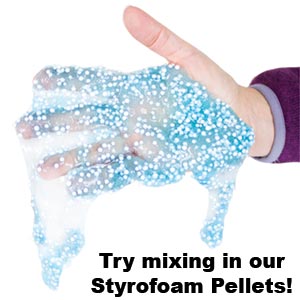 The other day, we were wondering what would happen if we added different materials into our slime. Styrofoam Pellets, for instance? The results were thrilling: the pellets easily melded together with the slime, creating an irresistible hybrid of Slime and Floam.
The other day, we were wondering what would happen if we added different materials into our slime. Styrofoam Pellets, for instance? The results were thrilling: the pellets easily melded together with the slime, creating an irresistible hybrid of Slime and Floam.
If we had added even more Styrofoam pellets, our concoction would have been more solid (like store-bought Floam) but we liked how this resembles a cluster of frog eggs.
We left our mixture in a Petri Dish overnight and came back to the office to discover another fascinating attribute of our Frog Floam: the pellets had separated from the denser slime and risen to the top of the mixture!
We’re still having fun with our homemade Frog Floam. Give it a try!


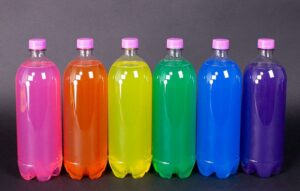
this is the science web page that I need to study for ok so I can have my project done in time………………..
The paper give me a lot of new chemical knowledge,thank you!
This will make a great science project for my 1st grader! Thank you!
You’re very welcome! Enjoy!
~Tami
i love this site
Thank you!
I’ve used bags that were donated from a hospital for several years. The recipe I used was a sheet 20 cm by 20 cm for each student. The student would dissolve it in 25 mL of water. Student would then add 5 mL of a mixture of borax and water(6.3 grams borax for every 100 mL of water). This made great slime. I had to order new bags this year and went with the ones from educational innovations. I’ve tried the same thing 3 times and get no slime. Directions appear to be for making a large amount of fluid with one bag and mixing in borax solution from there. Anyone know if there is a possible recipe that is similar to what I used before. I like it much better when the student gets to dissolve their own part of the bag. Any help would be greatly appreciated.
Thanks.
There is a recipe I use to make slime.
-1-2 cups of shaving cream
-4oz of elmers glue
-2 tbs eye contact solution
-liquid food coloring
My kids question is, Is oobleck and slime the same thing? Chemical speaking? One was to do oobleck and the other one slime for science fair this year…is there a ooblec vs slime scientific explanations?
I need a introduce a dilemma for essay about differences about slime and gak. Email me at aliana.barnes@stu.konoctiusd.org